The F-15 Eagle family is a family of fighter jets has three main versions: the F-15C Eagle, the F-15E Strike Eagle, and the F-15S/MTD. Each one with his respecitives variants.
F-15 Eagle[]
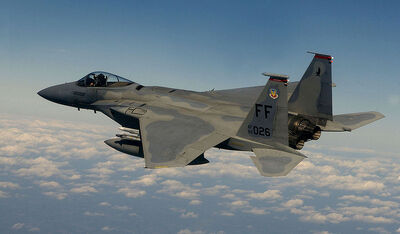
F-15C Eagle
The F-15 Eagle is an all-weather, extremely maneuverable, tactical fighter designed to permit the Air Force to gain and maintain air superiority in aerial combat.
The Eagle's air superiority is achieved through a mixture of unprecedented maneuverability and acceleration, range, weapons and avionics. It can penetrate enemy defense and outperform and outfight almost any current enemy aircraft. The F-15 has electronic systems and weaponry to detect, acquire, track and attack enemy aircraft while operating in friendly or enemy-controlled airspace. The Eagle can be armed with AIM-7F/M Sparrow missiles or AIM-120 advanced medium range air-to-air missiles on its lower fuselage corners, AIM-9L/M Sidewinder or AIM-120 missiles on two pylons under the wings, and an internal 20mm Gatling gun in the right wing root. The weapons and flight control systems are designed so one person can safely and effectively perform air-to-air combat.
The F-15's superior maneuverability, rate-of-climb and acceleration are achieved through high engine thrust-to-weight ratio and low wing loading. Low wing-loading (the ratio of aircraft weight to its wing area) is a vital factor in maneuverability and, combined with the high thrust-to-weight ratio, enables the aircraft to turn tightly without losing airspeed. As a result, the F-15 is one of the deadliest (and best) fighters ever built.
As of today, the F-15 kill ratio stands at 108 air-to-air victories and no air-to-air losses. The Eagle is used by America, Israel, Japan, and Saudi Arabia. It is currently being succeeded by the F-22 Raptor, though the U.S. Air Force will keep at least 178 combat-ready Eagles through 2025. The price for one F-15C is an estimated $29,900,000 USD.
F-15E Strike Eagle[]
Main Article: F-15E Strike Eagle
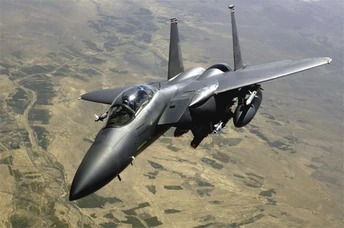
F-15E Strike Eagle
The F-15E Strike Eagle is a fighter-bomber aircraft designed to replace the F-111F Aardvark as Medium Bomber. The plans for a ground attack Eagle was formed ever since testing began of the original F-15A. However, it was abandoned in 1975, primarily due to increasing costs. It was revived in 1982 when trials began with a F-15B. The production model first flew December 11, 1986, after it's only competition, the F-16XL was canceled. The F-15's cockpit is state-of-the-art and the pilot has a wide angle Heads-Up Display as well as 3 Multi-Function Displays and the Weapons Systems Operator has 4 MFD's. The only advantage between the Strike Eagle (which was also known as the Beagle and the Mud Hen)and the Aardvark it replaced, is that it acquired air-to-ground capability, while retaining the F-15C's outstanding air-to-air capability. The disadvantage, which was criticized in its early life, was the fact that the F-15E didn't have the internal range (2,994 miles in the F-111 to 2,100 miles in the F-15E) nor the weapons payload capability (31,302 lbs to 24,471 lbs) as the Aardvark. However, despite these shortcomings, the F-15E is one of the most powerful aircraft in the U.S. arsenal, as proved in the Persian Gulf, the Middle East and the Balkans. Strike Eagles are used in other countries, including Israel (F-15I Ra'am), South Korea (F-15K Slam Eagle), Saudi Arabia (F-15S) and Singapore (F-15SG or F-15T).
F-15S/MTD[]
The F-15S/MTD (STOL/Maneuver
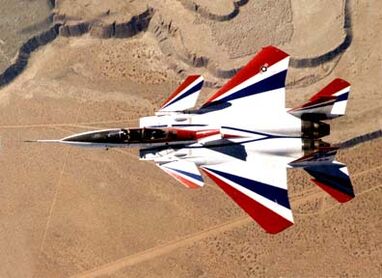
F-15/MTD
ability Technology Demonstrator) is an experimental technology demonstrator employed by NASA and built off of an F-15B airframe, initially used to test advancements in super-maneuverability and short take off and landing technologies. Initially funded as a military experiment, the F-15S/MTD was eventually aquisitioned by NASA and modified with multi-dimensional thrust vectoring nozzles and ACTIVE (Advanced Control Technology for Integrated Vehicles) technologies, meant to improve aircraft control and survivability in combat. The aircraft was easily capable of pulling Pugachev's Cobra maneuver, and in its S/MTD form, was equipped with thrust reversers, able to slow the aircraft down in a fraction of the time compared to conventionally equipped fighters. It managed a rotation speed of just 42 mph, and could land on a runway only a fraction the size of that required by the F-15C. By 1991 the project had ended in its S/MTD form and was deemed a success, and the technologies pioneered in the program would eventually be adapted to serve with the joint U.S./German X-31 program, and ultimately the F-22 Raptor program and its offshoot contemporaries.
F-15I Ra' am[]
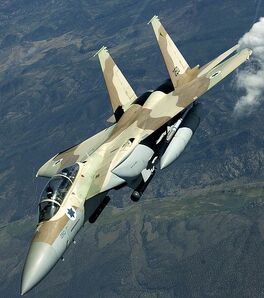
F-15I Ra' am
The F-15I is deployed by the Israeli Air Force where it is known as the Ra'am (רעם - "Thunder"). It is a dual-seat ground attack aircraft powered by two Pratt & Whitney F100-PW-229 engines, and is based on the F-15E.
After the Gulf War, in which Israeli towns were attacked by SCUD missiles based in Iraq, the Israeli government decided that it needed a long range strike aircraft. In 1993, Israel issued a Request for Information (RFI) asking any aircraft companies interested in producing the new Israeli fighter for their proposals.
In response, Lockheed Martin offered a version of the F-16 Fighting Falcon and McDonnell Douglas offered both the F/A-18 Hornet and the F-15E Strike Eagle. On 27 January 1994, the Israeli government announced that they intended to purchase 21 F-15Es. The F-15E design was modified to Israeli requirements, including the DASH helmet mounted sight and was renamed F-15I. On 12 May 1994, the US Government authorized the purchase of up to 25 F-15Is by Israel. In November 1995, Israel purchased 4 more F-15Is, bringing them to the US imposed limit. 25 were built from 1996 to 1998.
F-15SE Silent Eagle[]
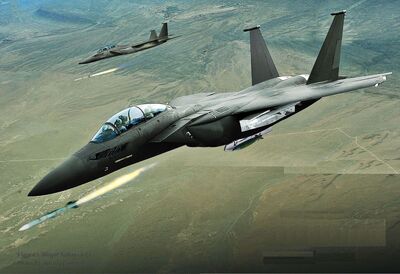
F-15SE Silent Eagle
The F-15SE is a new development of the highly popular and successful F-15E. With stealth capabilities extrapolated to be similar to export variants of the F-35 Lightning II, it is a formidable addition to the Eagle Family. It does away with the CFT's of the F-15E, replacing them with similarly-shaped internal weapons bays to increase its stealth properties. The F-15SE's entire tail section has been redesigned, with outrward-canted tailfins, much like the F/A-18. The new Eagle is reportedly made of new radar-absorbent composite materials, and the rear section of the F-15SE has been fitted with highly classified new electronic countermeasure equipment sets.
List of Variants[]
- F-15A
- F-15B- (two-seat combat capable trainer).
- F-15C- (upgraded F-15A).
- F-15D- (upgraded 2 seat F-15C).
- F-15E Strike Eagle (tactical strike version of F-15B).
- F-15F Strike Eagle- (proposed single-seat F-15E).
- F-15I Ra'am - (Israeli F-15E).
- F-15J- Japanese built F-15C (DJ=Japan-F-15D).
- F-15K Slam Eagle- (South Korean F-15E with major improvements).
- F-15N Sea Eagle- (Never left the drawing boards).
- F-15SG- (Singaporean F-15E similar to the F-15K).
- F-15S/MTD- (modified F-15B with canards, used by NASA only).
- F-15S- F-15E sold to the Royal Saudi Air Force with downgraded radar.
- F-15EX- Next generation Eagle II based off the Strike Eagle
See also[]
- F-15C Eagle
- F-15E Strike Eagle
- F-15S/MTD
The original article can be found at F-15 Eagle family and the edit history here.